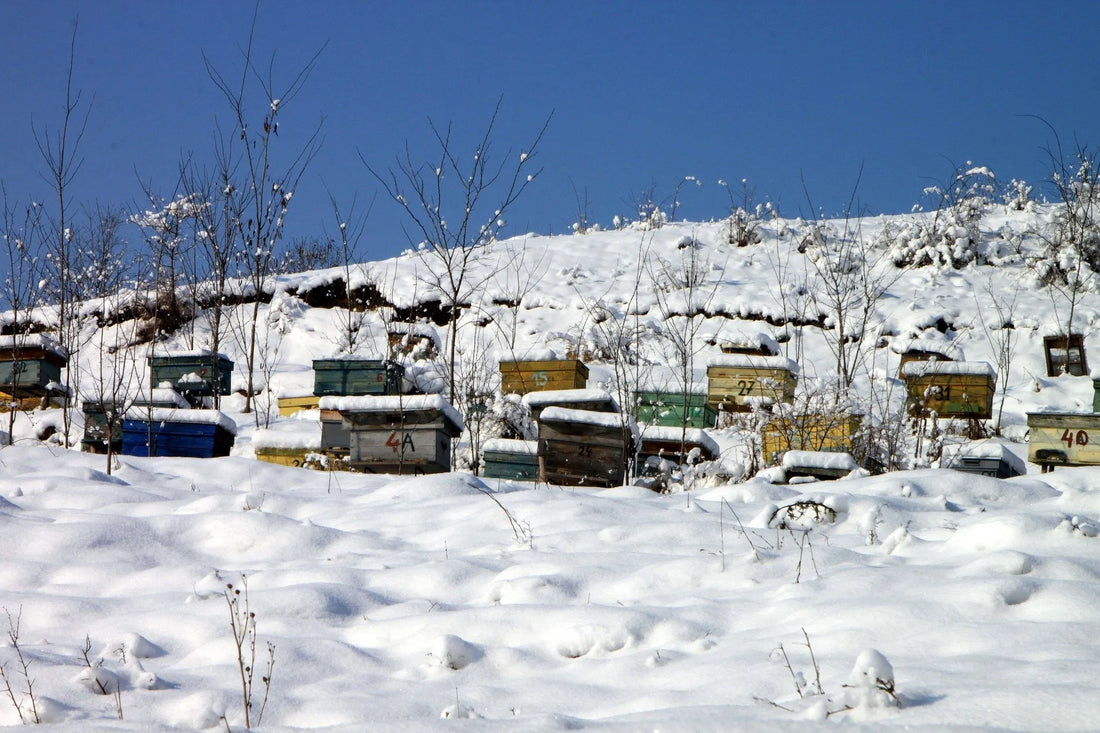In the winter season it may be easy to forget about our fuzzy friends, but have you ever wondered where bees go in the winter and how they cope through the colder months? Our guest writer and bee enthusiast Mitchel Rowe set out to explore how different bee species survive the cold weather and how we can help our bees during this time.
Honeybees & bumblebees
Many species of bee are akin to other common animals, hiding away and hibernating. Honeybees are no exception, as they can and will survive throughout the winter despite their usual plethora of flowers and warmth. As the winter approaches workers begin to prepare for the cold months by foraging red-jewelled propolis to fix the gaps in the hive and help with insulation. Male bees, called drones are thrown out of the colony by their sisters and the queen lays fewer eggs to shrink the brood (young bees). As the temperature drops and it gets too cold to fly, the small winter colony will cluster in a rugby ball-like formation around the brood and queen, sharing their body heat and vibrating their flight muscles to help keep warm. The storage of honey is also imperative to a hive's survival over winter. Bees use these stores to feed from over the long winter months!
A Beekeeper will generally help the honeybees prepare for winter by checking the hives are in good condition, carrying out repairs and trimming overgrown foliage to allow for ventilation and to keep entrances clear. Beekeepers may also assist by providing their colonies with a sugar syrup to keep them going. During warmer winters bees are encouraged to be more active and therefore use up their reserve much faster than anticipated. This is when a specifically formulated sugar water solution like ambrosia can be fed to the hive to help them build up their honey stores when low, to survive.
Top tip: One way that we can help our honeybees is by planting flowers that bloom at different times of year, so they have plenty to feed from to build up their stock for the winter hive. Here is a inspiring guide by RHS.
 Photography credit to Emilian Robert Vicol
Photography credit to Emilian Robert Vicol
It may be interesting to know that Bumblebees differ vastly from the honeybee. The queen bumble bee can live alone and they have an annual lifecycle. In a Bumblebee hive, the old queens, workers and males fall away with the leaves, dying in the autumn and the new chosen queen is the only bee left to survive. The queen often seeks shelter underground in empty nests, under logs or burrowed in soft soil, where they are hidden and protected from pests and the cold. They enter a resting state, similar to mammals and can be expected to live half their life in hibernation. The queen bee will emerge at the beginning of the year and begin feeding to build up strength. This is in preparation to build her nest and continue the cycle once again.
Queen bees can often be spotted during the winter months as they surface to feed or get confused by warm weather. If you spot one that appears to be unwell on the ground or perhaps soaking wet, try to find shelter and a nearby flowering plant to place her on. If you cannot find any nearby flowers and you are sure she is not just resting, then you can use your Bee Revival Kit to feed the tired bee a one-off energy boost with the sugar water solution inside.
Top tip: It maybe tempting to bring her inside but only do so for a very short period as she needs to be outside in her natural habitat and may have a nest to return to!
 Pantaloon bee, photo by AxxLC
Pantaloon bee, photo by AxxLC
Solitary bees survival
Solitary bees are a hugely diverse and important species, making up 90% of the British population of bees. They have a short but busy annual life cycle! They survive winter in different ways but unlike honeybees and bumble bees the adults will pass before the winter arrives.
The female bee works hard throughout the summer spending all their time gathering pollen and nectar for the young. Once enough has been gathered she will lay her eggs inside a cavity, burrow or a bee hotel. Sealing the nest with a store of food for the bees that will hatch later!
During the winter months, the eggs will become larvae and eventually turn into young bees. Most solitary bees are eager to emerge as soon as possible in Spring to fly and take advantage of the early flowering plants. Unfortunately, the life span for adult solitary bees is short; sometimes only a matter of weeks, and this means the mother may never get to meet their young.

So...
Whilst you are walking your dogs in the countryside, digging in your garden, or exploring the frost bearing forests you are most likely surrounded by thousands of solitary bees. They maybe burrowed, nested and hidden away among the shrubs around you, waiting for the cold seasons to end so that they can buzz around during the sunny days from flower to flower pollinating our planet.
Let's keep spreading the bee love to save the bees in 2021!


